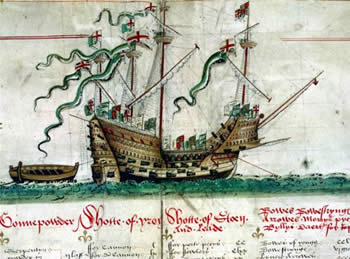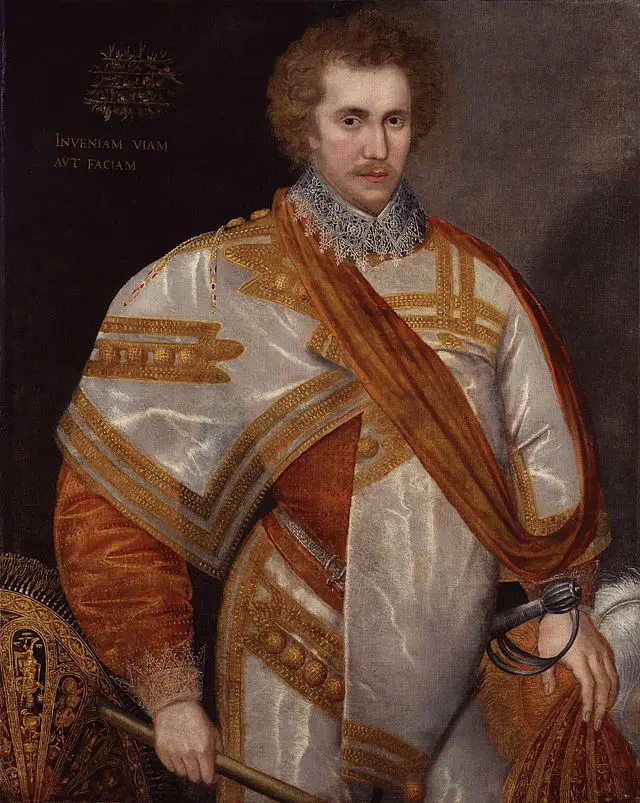 Lady Jane Grey had been chosen by Edward VI as his heir and became queen on his death on 6th July 1553. However, Edward's half-sister Mary believed herself to be Edward's true heir and so declared herself queen at her home at Kenninghall following news of Edward's death. On 12th July 1553, Mary moved from Kenninghall to Framlingham Castle, where she began to rally support and between 12th and 15th July Mary's supporters and forces grew. She was supported by men such as Sir Edward Hastings; Henry Radclyffe, Earl of Sussex; Sir Thomas Cornwallis; Thomas, Lord Wentworth; Sir Henry Bedingfield; John de Vere, Earl of Oxford; and many prominent families of eastern England such as the Rochesters, the Jerninghams and Waldegraves. Mary was proclaimed Queen in various counties and towns.
Lady Jane Grey had been chosen by Edward VI as his heir and became queen on his death on 6th July 1553. However, Edward's half-sister Mary believed herself to be Edward's true heir and so declared herself queen at her home at Kenninghall following news of Edward's death. On 12th July 1553, Mary moved from Kenninghall to Framlingham Castle, where she began to rally support and between 12th and 15th July Mary's supporters and forces grew. She was supported by men such as Sir Edward Hastings; Henry Radclyffe, Earl of Sussex; Sir Thomas Cornwallis; Thomas, Lord Wentworth; Sir Henry Bedingfield; John de Vere, Earl of Oxford; and many prominent families of eastern England such as the Rochesters, the Jerninghams and Waldegraves. Mary was proclaimed Queen in various counties and towns.
On this day in history, 15th July 1553, the royal ships guarding the Eastern coast for Queen Jane swapped their allegiance to Queen Mary. Their crews had not been paid, and they received a visit from Sir Henry Jerningham asking them to support Mary instead, so it was an easy decision. In The Navy of Edward VI and Mary I, C.S. Knighton explains that "Sir Henry Jerningham (d. 1572) had been in Mary's service since 1528 and had gone at once to join her at Kenninghall; he then mustered support for her cause in Suffolk [...] Jerningham heard of the ships in the Orwell from a drunken sailor late on the night of 14 July, and found them beached at Landguard Point early next morning."1 Robert Wingfield of Brantham, who accompanied Jerningham, recorded the following in his Vita Mariae Angliae Reginae:
"Very early the next day Jerningham, accompanied by Tyrrell and Glemham, rode up to inspect the ships thus brought to the haven by a lucky tide and wind, as they say. When they had reached the haven he ordered Richard Brooke, the squadron's commander, a diligent man and skilled in seamanship, to be called to him, and took him to Framlingham castle to bring news of this happy and unexpected arrival to the queen.
This happened on 15 July; next day Thomas, Lord Wentworth arrived, to avoid the appearance of breaking his pledge, clad in splendid armour and accompanied by a not inconsiderable military force, besides several gentlemen of the county who were wont to go in his company. I would like to record for this treatise the more notable men who led any of the military reinforcements for this loyal campaign. There was Sir Richard Cavendish, a veteran campaigner, with his two sons; Sir Henry Doyle, also with two sons; Robert Wingfield, son of the late Sir Anthony Wingfield K.G., with his two brothers Anthony and Henry; Lionel Tollemache, a man well-supplied with ancient lineage and wealth; Edward Withipoll, a man of diligence; John Southwell and Francis Nunn, both lawyers; Robert Wingfield of Brantham; John Colby, an experienced soldier, with his two brothers; Jennings, skilled in warfare, and others not less active whom I forget at the moment. That nobleman, most striking both in appearance and dress, came with a splendid force of both heavy and light horse and of infantry. There is no doubt that his arrival wonderfully strengthened the morale of the queen's army and much dispirited the enemy."2
The Chronicle of Queen Jane records:
"About this tyme or therabouts the vj. shippes that were sent to lie befor Yarmothe, that if she had fled to have taken hir, was by force of wether dreven into the haven, w(h)er about that quarters one maister Gerningham was raysing power on quene Maryes behalfe, and hering therof came thether. Wherupon the captaynes toke a bote and went to their shipes. Then the marynours axed maister Gernyngham what he wolde have, and wether he wolde have their captaynes or no; and he said, "Yea, mary." Saide they, " Ye shall have theym, or els we shall throwe theym to the bottom of the sea." The captaynes, seing this perplexity, saide furthwith they wolde serve quene Mary gladlie ; and so cam fourthe with their men, and convayed certeyn great ordenaunce; of the which comyng in of the shipes the lady Mary and hir company were wonderfull joyous, and then afterwarde doubted smaly the duke's puisance."3
Just four days later, Mary was proclaimed queen.
See Mary I Proclaimed Queen - 19 July 1553 for a timeline of events leading up to Mary being proclaimed queen. You can also check out the Lady Jane Grey and Mary I primary sources pages.
Notes and Sources
- Knighton, C.S. (2011) The Navy of Edward VI and Mary I, p. 282.
- edited and translated by MacCulloch, Diarmaid (1984) THE VITA MARIAE ANGLIAE REGINAE OF ROBERT WINGFIELD OF BRANTHAM, Camden Fourth Series / Volume 29 / July 1984, pp 181 - 301, p. 259.
- Nichols, John Gough (1850) The chronicle of Queen Jane, and of two years of Queen Mary, and especially of the rebellion of Sir Thomas Wyat, Camden Society, p. 8-9.



Leave a Reply